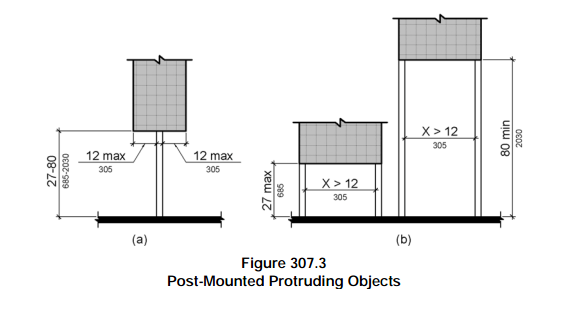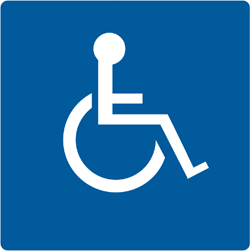Did you know that the Americans with Disabilities Act (ADA) Standards for Accessible Design were augmented on March 15, 2012? New rules relating directly to facility management have been put into place, and we’re here to tell you a little bit about them.
The language in this document is thick, so we’ve tried to break it down, and pull the clauses that relate directly to facility management. Note that the regulations apply to facility construction and/or alterations (see FAQ #1 for definition).
802.1.2 Width: A single wheelchair space shall be a minimum of 36 inches (915mm). Where two adjacent wheelchair spaces are provided, each wheelchair space shall be 33 inches (840 mm) wide minimum.
307.3 Post-Mounted Objects: On a post and rope system, or retractable belt barrier, if the distance between stanchions (or posts) is more than 12”, the rope must not be more than 27” off of the ground. This also applies to signs between posts.
If a sign is posted on a stanchion, the edges of the sign on either side may not encroach the circulation path more than 12.” That 12” measurement begins with the finished floor. Thus, if you’re using a stanchion with a base, the measurement begins where the base ends.
The above rule also applies to freestanding signs.
307.5 Required Clear Width: Protruding objects shall not reduce the clear width required for accessible routes. Thus, if a sign overhangs the path, the 36” (or 33”) is measured from the edge of the sign.
Remember this when setting up your queue, because you must be sure that there is a 36” (or 33”) path for wheelchairs
Here are some Frequently Asked Questions Related to the regulations:
Q: What constitutes an alteration?
A: A change to a building or facility that affects or could affect the usability of the building or
a portion of the building.
Alterations include, but are not limited to, remodeling, renovation, rehabilitation, reconstruction, historic restoration, resurfacing of circulation paths or vehicular ways, changes or rearrangement of the structural parts or elements, and changes or rearrangement in the plan configuration of walls and full-height partitions.
Normal maintenance, reroofing, painting or wallpapering, or changes to mechanical and electrical systems are not alterations unless they affect the usability of the building or facility.
Q: What types of facilities do these standards apply to?
A: All facilities; public and private alike.
Q: What will happen if my facility is non-compliant?
A: If ADA officials find that your building is non-compliant, you may be forced to make the necessary changes. Lawsuits have also occurred as a result of non-compliance. See Mt. Vernon lawsuit.
Q: I haven’t had a problem yet, why/how will I in the future?
A: If a disabled person tries to access your facility and is denied or unable to due to a lack of accessibility options, a complaint will most likely be filed, and your building will come under investigation. ADA officials also perform random evaluations.
Q: Will this cost me more money?
A: This is a tricky question. If you’re a operating new facility, or you’re beginning to renovate, it’s simply a matter of buying the right equipment, and setting it up in the proper manner. When purchasing equipment from LineLogic.com, there will be an icon to tell you if the equipment is ADA compliant. We also have an ADA information page with a lot of the same tips and information from this post, which you’ll be able to access at any time.
For an existing facility, evaluate the equipment and setup you have, and make the necessary changes. The costs to become compliant will pale in comparison to violation fees and expenses.
Q: Why should I be concerned with ADA compliancy?
A: Why should you buy fire insurance for your house? Here’s three main reasons:
1.) Avoiding Unnecessary Expenses: Non-compliance can lead to lawsuits and bad PR; both of which will cost your company money.
2.) Revenue Increases: The U.S. Department of Labor has projected the buying power of the disabled population at $220 billion, larger than the $170 billion teen market.
3.) It’s the Right Thing To Do: If for no other reason than a moral obligation. It’s the right thing to do.
We hope this post has helped you better understand the ADA Standards for Accessible Design. If you encounter any questions or concerns about the equipment or the regulations, please feel free to contact us, and we will do our best to work you through them.


